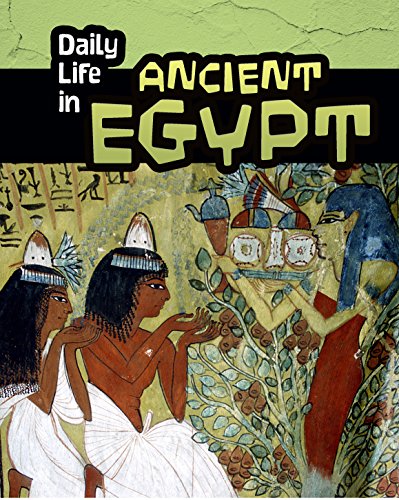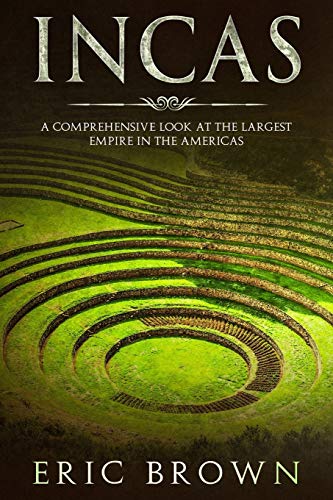-
The Phoenicians: Mysterious Sea People
Katherine Reece
Library Binding (Rourke Pub Group, Jan. 1, 2005)Rare Book V
V
-
The Aztec Empire
Sunita Apte
Paperback (Children's Press, Feb. 11, 2010)Explore the Aztec empire, includingTenochtitlâan, daily life, and ruins.A True Book: Ancient Civilizations series allows readers to experience what makes each ancient civilization distinctive and exceptional as well look at its influence on the some of the practices of the modern world. This series includes an age appropriate (grades 3-5) introduction to curriculum-relevant subjects and a robust resource section that encourages independent study. S
S
-
The Ancient Maya
Jackie Maloy
Paperback (Children's Press, Feb. 11, 2010)Explore ancient Maya, including farming, daily life, and beliefs.A True Book: Ancient Civilizations series allows readers to experience what makes each ancient civilization distinctive and exceptional as well look at its influence on the some of the practices of the modern world. This series includes an age appropriate (grades 3-5) introduction to curriculum-relevant subjects and a robust resource section that encourages independent study. S
S
-
The Inca Empire
Sandra Newman
Paperback (Children's Press, Feb. 11, 2010)Explore the Inca empire, including how the Incas survived in the mountains, how the empire was built, and why it disappeared.A True Book: Ancient Civilizations series allows readers to experience what makes each ancient civilization distinctive and exceptional as well look at its influence on the some of the practices of the modern world. This series includes an age appropriate (grades 3-5) introduction to curriculum-relevant subjects and a robust resource section that encourages independent study. S
S
-
Ancient China
Mel Friedman
Paperback (Children's Press, Feb. 11, 2010)Explore the history, culture, peoples, beliefs, and inventions of ancient China.A True Book: Ancient Civilizations series allows readers to experience what makes each ancient civilization distinctive and exceptional as well look at its influence on the some of the practices of the modern world. This series includes an age appropriate (grades 3-5) introduction to curriculum-relevant subjects and a robust resource section that encourages independent study. S
S
-
Ancient Greece
Diane Bailey
Library Binding (Essential Library, Jan. 1, 2015)Describes the history, daily life, religion, and social customs of ancient Greece.
-
Ancient Rome: A History From Beginning to End
Hourly History
Paperback (CreateSpace Independent Publishing Platform, Dec. 12, 2016)Ancient RomeRome is a city of myth and legend. The Eternal City, the city of the seven hills, the sacred city, the caput mundi, the center of the world, Roma, Rome, by any of her many names is a city built of history and blood, marble and water, war and conquest. Inside you will read about...✓ Legendary Beginnings✓ The Senate and the People✓ Ave Caesar✓ Empire✓ Rulers of the World✓ The Fall✓ Legacy From legendary beginnings, a city rose from the swamp surrounded by the seven hills and split by the Tiber River. Built and rebuilt, a sacred republic and a divine empire, blessed by a thousand gods and by One, the story of her rise and fall has been told and retold for a thousand years and is still relevant in today’s world, as echoes of her ancient glory have shaped our culture, laws, lifestyle and beliefs in subtle and pervasive ways.
-
In God's Path: The Arab Conquests and the Creation of an Islamic Empire
Robert G. Hoyland
Paperback (Oxford University Press, May 1, 2017)In just over a hundred years--from the death of the Mohammed in 632 to the beginning of the Abbasid Caliphate in 750--the followers of the Prophet swept across the whole of the Middle East, North Africa, and Spain. The conquered territory was larger than the Roman Empire at its greatest expansion, and it was claimed for the Arabs in roughly half the time. How they were able to engulf so many empires, states, and armies in such a short period of time is a question which has engaged historians since at least the ninth century. Most recent popular accounts have been based almost solely on the early Muslim sources, which were, in short, salvation history, composed for the purpose of demonstrating that God had chosen the Arabs as his vehicle for spreading Islam throughout the world. While exploiting the rich biographical and geographical information of the early Muslim sources, this groundbreaking work delivers a fresh account of the Arab conquests and the establishment of an Islamic Empire by incorporating different approaches and different bodies of evidence. Robert G. Hoyland, a leading Late Antique scholar, accomplishes this by first examining the wider world from which Mohammed and his followers emerged. For Muslim sources, the revelation of Islam to Muhammad is the starting point for their history, and modern university departments have tended to reinforce this approach. Late Antique studies have done us the service of shedding much needed light on the 4th to 6th centuries, thus giving us a better view of the nature of Middle Eastern society in the decades before the Arab conquests. In particular, Hoyland narrates the emergence of a distinct Arab identity in the region of the Roman province Arabia and western (Saudi) Arabia, which is at least as important for explaining the Arab conquests as Muhammad's revelation. The Arabs are the principal, almost sole, focus of the Muslim conquest narratives, and this is the norm for modern works on this subject. Yet, in the same period the Khazars, Bulgars, Avars and Turks established polities on the edges of the superpowers of Byzantium and Iran; in fact, the Khazars and Turks continued to be major rivals of the Arabs in the seventh and eighth centuries. The role of these peripheral states in the Arab success story is underscored in the narrative. Innovative and accessible, In God's Path is a welcome account of a transformative period in ancient history.
-
Daily Life in Ancient Egypt
Don Nardo
Paperback (Heinemann, Jan. 1, 2015)What was life really like for everyday people in Ancient Egypt? In this detailed exploration of daily life in one of history’s greatest civilizations, readers will use primary sources and information from archeological discoveries to discover fascinating insights and debunk popular myths. Immersive timelines, maps and references to important people and events will bring children on a time-traveling journey through Ancient Egypt. V
V
-
Incas: A Comprehensive Look at the Largest Empire in the Americas
Eric Brown
Paperback (CreateSpace Independent Publishing Platform, Aug. 19, 2018)Discover The Largest Empire In The Americas!Buy the paperback version of this book, and get the kindle ebook version included for FREE!Have you always wanted to learn about the great Inca Empire, but your schoolteachers refuse to listen? Are you confused between Inca, Aztec, and Maya? Do you want to learn how the Inca people were unique from their Mesoamerican predecessors? Could you even draw the Inca Empire on a map?All this and more will be covered within the pages of Incas: A Comprehensive Look at the Largest Empire in the Americas. Their history is a relatively short, but vibrant and dynamic story with an ending so tragic, your favorite fantasy author couldn’t have come up with it himself. So little is taught of the native cultures of the Western Hemisphere in schools today, as curriculums lean on the exploits of Rome and Britain. If you’ve always wanted to learn more about the great people that once ruled the mountains of Peru and Chile, this is the book for you. If you’re tired of reading about stuffy old white men, this is the book for you. If you’re interested in history but have a hard time understanding the textbooks, this is the book for you! This simple but comprehensive look takes you across the Inca Empire from beginning to end. Everything you need to know about those great people is right past the front page.From its founding in the 1300s, the Inca Empire lasted roughly twelve generations. In just that time, it accomplished what other civilizations took centuries to achieve. Learn about the effective expansionist policy of the Inca, and how they maximized profits by leaning on clever marketing tactics instead of war. Learn how downfall came at the hands of the Spanish conquerors, who came with guns and steel and plague. Like the meteor that killed the dinosaurs, the invaders were an extinction-level event that the Inca had no way of preparing for. See how unmatched they were in strategy, technology, and how their far superior numbers meant nothing in the end. Learn what remains of their great civilization, what influence they had over the following course of history and See how they even had an effect on the soda you drink...Inside you will find:How an empire grew from such humble, and hostile, beginningsThe geographic location of the EmpireThe incredible natural odds the Incan people overcameSociety, government, and other everyday practicesAn in-depth look at the Incan godsThe terrible Civil WarThe ConquistadorsAnd more…So click ‘Add to Cart’ and begin your journey into the past. By the time you’ve finished, you’ll be booking that trip to Machu Picchu you’ve always wanted. And what’s more, you will be going armed with knowledge and respect of the great people who built the city, and who once ruled the mountains like gods. Don’t wait another moment to enjoy from this information – Get your copy of Incas right away!
-
Ancient Greece
Sandra Newman
Paperback (Children's Press, Feb. 11, 2010)Explore ancient Greek civilization, its history, city-states, government, religion, arts, sciences, and warfare.A True Book: Ancient Civilizations series allows readers to experience what makes each ancient civilization distinctive and exceptional as well look at its influence on the some of the practices of the modern world. This series includes an age appropriate (grades 3-5) introduction to curriculum-relevant subjects and a robust resource section that encourages independent study. S
S
-
Rome Resurgent: War and Empire in the Age of Justinian
Peter Heather
Hardcover (Oxford University Press, June 1, 2018)Between the fall of the western Roman Empire in the fifth century and the collapse of the east in the face of the Arab invasions in the seventh, the remarkable era of the Emperor Justinian (527-568) dominated the Mediterranean region. Famous for his conquests in Italy and North Africa, and for the creation of spectacular monuments such as the Hagia Sophia, his reign was also marked by global religious conflict within the Christian world and an outbreak of plague that some have compared to the Black Death. For many historians, Justinian is far more than an anomaly of Byzantine ambition between the eras of Attila and Muhammad; he is the causal link that binds together the two moments of Roman imperial collapse. Determined to reverse the losses Rome suffered in the fifth century, Justinian unleashed an aggressive campaign in the face of tremendous adversity, not least the plague. This book offers a fundamentally new interpretation of his conquest policy and its overall strategic effect, which has often been seen as imperial overreach, making the regime vulnerable to the Islamic takeover of its richest territories in the seventh century and thus transforming the great Roman Empire of Late Antiquity into its pale shadow of the Middle Ages. In Rome Resurgent, historian Peter Heather draws heavily upon contemporary sources, including the writings of Procopius, the principal historian of the time, while also recasting that author's narrative by bringing together new perspectives based on a wide array of additional source material. A huge body of archaeological evidence has become available for the sixth century, providing entirely new means of understanding the overall effects of Justinian's war policies. Building on his own distinguished work on the Vandals, Goths, and Persians, Heather also gives much fuller coverage to Rome's enemies than Procopius ever did. A briskly paced narrative by a master historian, Rome Resurgent promises to introduce readers to this captivating and unjustly overlooked chapter in ancient warfare.